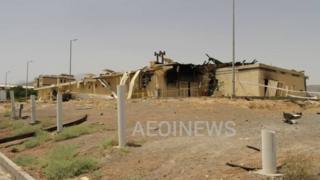Iran nuclear: 'Incident' at Natanz uranium enrichment facility
 Image copyright
@aeoinews
Image copyright
@aeoinews
Iran says there has been an "incident" at one of its nuclear facilities.
Atomic Energy Organisation of Iran (AEOI) spokesman Behrouz Kamalvandi did not give details of what happened at the Natanz uranium enrichment plant.
But he said the incident took place in a building that was under construction, and that there were no casualties or concerns about contamination.
The governor of Natanz city was later quoted by Tasnim news agency as describing the incident as a fire.
Ramazanali Ferdowsi said fire fighters and rescue teams had been deployed to the site, which is about 250km (155 miles) south of the capital, Tehran.
Later, the AEOI released a photograph purportedly showing the building where the incident occurred. Its roof was damaged and one wall was charred.
The International Atomic Energy Agency (IAEA), which monitors Iran's compliance with a 2015 nuclear deal struck with world powers, said it was aware of the reports about the Natanz incident and currently anticipated no impact on its activities.
Under the accord, Iran agreed to limit its sensitive nuclear activities and allow in international inspectors in return for the lifting of crippling economic sanctions.
The incident at Natanz comes six days after an explosion near a sensitive military site east of Tehran, which Iran said was caused by "leaking gas tanks".
The Parchin military complex is where Western powers suspect Iran carried out tests related to nuclear warhead detonations more than a decade ago. Iran has denied seeking to develop nuclear weapons.
Natanz is Iran's largest uranium enrichment facility.
It consists of three large underground buildings capable of holding tens of thousands of centrifuges. Uranium hexafluoride gas is fed into them to separate out the most fissile isotope, U-235.
The 2015 nuclear deal saw Iran agree only to produce low-enriched uranium, which has a 3-4% concentration of U-235 and can be used to produce fuel for nuclear power plants. Weapons-grade uranium is 90% enriched or more.
Iran also agreed to install no more than 5,060 of the oldest and least efficient centrifuges at Natanz until 2026, and not to carry out any enrichment at its other underground facility, Fordo, until 2031.
Last year, Iran began rolling back these commitments in retaliation for US President Donald Trump's decision to abandon the nuclear accord and reinstate sanctions.
In November, Iran said it had doubled the number of advanced centrifuges being operated at Natanz and begun injecting uranium hexafluoride gas into centrifuges at Fordo.